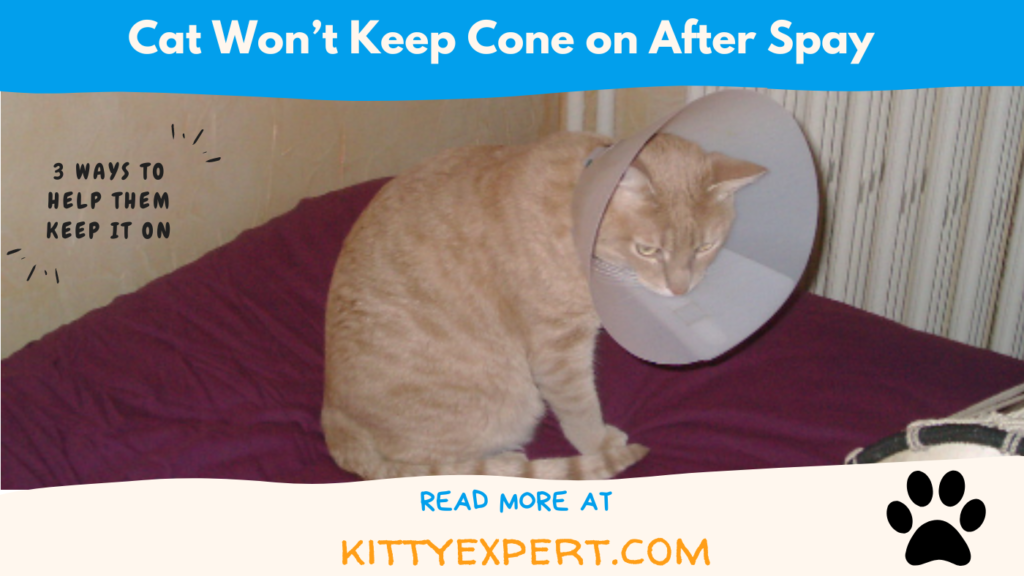After a cat has received medical spay, it is likely that it will be required to wear a cone for up to two weeks post-operation. Even though your cat probably won’t be a fan of the cone, it is essential that they keep it on for the recommended period of time. In this article, we’ll discuss various ways to make sure your cat keeps their cone on despite their protests to help it heal swiftly and safely.
There is a good chance your cat will protest the cone and guilt you into letting them take it off – here is where tough love comes in. It is crucial to ensure your cat keeps wearing the cone until they have healed to prevent prolonged healing or even potentially deadly infection. If you are worried that your cat might already have an infection, you should check out my article on what should a healing cat spay incision look like.
What to do if cat won’t keep cone on after spay?
If you cat won’t wear the cone, make sure you have one that is properly sized, desensitize your cat to the cone, and be firm and assertive.
Properly Fit the Cone

If a cone is not properly situated on your cat’s head, it will be very easy for them to slip it off. And, more likely than not, they will be desperately trying to slip it off. So, make sure you know how to properly fit the cone onto their head to ensure they can’t take it off by themselves.
To properly fit the cone around your cat, adjust the collar to be close to the neck. You should be able to comfortably fit your finger in the space between the collar and the neck, otherwise, it is too tight. Even though it should be tight, the collar shouldn’t be pressing into the skin. On the other hand, if you can fit two or three fingers in the same space, it is too loose. Once you’ve made sure the collar is securely fitted around its neck, you’re setting yourself up for success by preventing your cat from removing the cone itself.
You should also make sure your cat can easily access their food with the cone. It is common for cats to eat more after getting spayed.
Desensitize your Cat to the Cone
Your cat is likely to have an adverse reaction to the cone because it obscures some of its vision and restricts its movements. Therefore, a negative reaction is perfectly normal, so try not to get upset at your cat.
Getting your cat used to and desensitized to the cone is the best way to make the adjustment process easier. If possible, try to contact your veterinarian a few weeks prior to the surgery and request a training cone. Then, try practicing with your cat a few times a day. Put it on, leave it on for a few minutes, and then take it off. Put it on before essential parts of their routine like eating and playing, so they can get used to the cone.
If your cat is more familiar with the cone and how it feels, it will be less likely to try and remove it post-op. You should also make sure that your don’t leave the cone on longer that you need to. To learn more, check out my article on how long to keep cone on cat after spay.
Be Firm and Assertive
As much as wearing a cone can be stressful for your cat, it can also take a toll on you! It can be difficult to watch your cat struggle with wearing its cone, even though you know it is necessary for its healing journey.
However, it is important to not let your cat guilt you into taking off the cone. And oh will they try. Your cat might frantically try to take it off, bump into walls and couches, and even protest the cone by not eating or drinking. But, as dramatic as it may be acting, your cat is not in any danger due to the cone.
In fact, the cone is keeping your cat safe from infection. In extreme cases where your cat is refusing to eat, try holding the bowl up to its mouth or propping it up on a step making it easier to access. If it still won’t eat, consult with your vet to see what your next step should be. However, in most cases, it is just your cat being dramatic.
Final Thoughts
The cone is a dreaded experience for both cats and their owners. However, it is essential to ensure your cat heals properly from their spay. Without the cone, your cat may excessively lick at the wound and tear out stitches. This will lead to an extended healing process and could even lead to dangerous or deadly infections. Therefore, it is important to keep a close eye on your cat to make sure they aren’t removing the cone.
By properly securing the cone, doing desensitizing training prior to the surgery, and not letting their pity looks and guilt-tripping get the best of you, you are making sure your cat has an easy, safe healing journey. Aside from using a cone, it is also important that you keep your cat confined after they get spayed.

